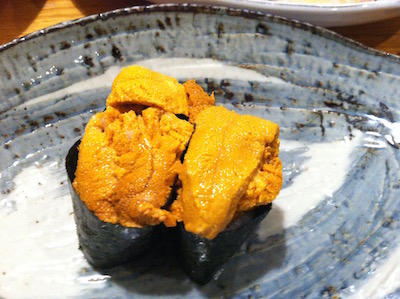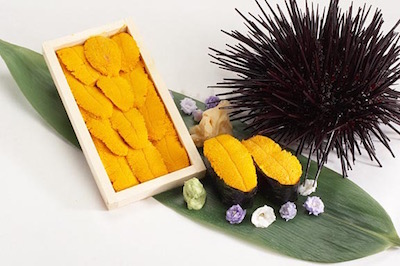International Love Affair with Sea Urchin
(Gerry Furth-Sides)
You either love it or hate it, and it was love at first bite for me with uni (the Japanese word for sea urchin roe). The gold- colored little gems resembling a kitten’s tongue taste like a cloud and are soft to the point of trembling. When they melt in your mouth, it produces an explosion of vibrant ocean flavor every time.
Ancient Apollonian Greeks reveled on wine, dipping bread, and the sea urchin they harvested at water’s edge. I first tasted uni in the 70’s, just as the California sea urchin fishery began in earnest, due to a growing demand for traditional Asian cuisine. In those days sea urchins were considered pests, both to kelp harvesters and sports divers alike.
From those lowly beginnings, the sea urchin crop has risen to rank among California’s most important fisheries. Dave Rudie of the California Sea Urchin Commission explains it as, “Among the world’s harvesters, only California has the temperate climate and favorable ocean environment that allow divers to bring in high-quality red sea urchins, even in the dead of winter.”
Sea urchins are named from the Olde English for the round spiky hedgehogs they resemble. A one to four-inch shell (called a test) covers their spiny-covered whimsical round shapes. Rudie tells us, “ All California Red Sea Urchins, which can be red or black in color, are edible. This family has five parts and you may be more familiar with its members in the form of sea urchins, starfish, sand dollars and sea cucumbers. Uni are also invertebrate – just like insects you see on land.”
Another oddity: sea urchins and humans are astonishingly alike —genetically speaking. “A recent sequencing reveals a striking number of similarities in the genes,” notes George Weinstock, Co-director of the Human Genome Sequencing Center at Baylor College of Medicine in Houston, Texas.
Each sea urchin spiny shell holds five pieces of the precious, firm roe, each well defined, with a shine to it and no moisture on top. According to Rudie, “Processing sea urchin requires carefully cracking the shell with a pointed instrument to separate the halves and expose the delicate roe without damaging it. Then the uni is meticulously spooned out, dipped in salt water, very carefully washed by hand and treated with a stabilizer before being graded and packed – all within 48 hours of being unloaded from a diver’s vessel.”
You next see them in the market, or neatly tucked between other sushi ingredients on a shelf, in their traditional pine wooden trays. They sell from $10 to $15 each ( 1.5 to 2 ounces).
Initially, nearly all California uni was exported to Japan. Reports Rudie, “Today, approximately one third of the 800,000 pounds or so of harvested uni is eaten in the U.S. to the tune of $9 million wholesale, in comparison to the $12 million in international trade. ”
Participants in California’s sea urchin fishery support responsible resource management. The industry imposed an assessment on itself to fund management, research and enhancement projects as early as the 1980’s. Trained, volunteer divers collect scientific data during normal fishing operations on a scale never before attempted. Thermometers to monitor the temperature of the sea urchin have most recently been introduced. Talk about new and improved!
The California Sea Urchin Commission was created in 2004 as an industry advocate. In Rudie’s description, “The commission creates and maintains high standards, conducts independent scientific research and quality improvement projects, and basically gets the word out to the public. We operate under state law, and are funded equally by dedicated divers and handlers.”
Last November, the Commission adopted standard grades for buyers, sellers, harvesters and the public, noted the Executive Director, Vern Goehring. Uni had already been graded A, B and C by the industry.
The new, more descriptive names are California Gold, Premium California and Select California. All of the categories still boast of a “salty, ocean scent.” The colors range from brilliant gold to hues of much less bright yellow or brown. The top grades have a sweet buttery taste and firm texture, and the intact pieces for use in sushi and sashimi. Premium and Select taste more nutty than buttery and are less firm. They are usually used in soups and seafood stews.
To you about to try uni for the first time, I advise food writer’s Jeffrey Steingarten’s notorious “eat it eight times” rule before making up your mind. Make round one Zip Fusion Restaurant’s delicate uni sushi topped with caviar alongside a mini-seaweed salad for a true gourmet taste of the sea.



 Gerry Furth-Sides
Gerry Furth-Sides  Barbara Hansen
Barbara Hansen  Chef-owner Alain Cohen
Chef-owner Alain Cohen  Roberta Deen
Roberta Deen  Jose Martinez
Jose Martinez  Nivedita Basu
Nivedita Basu